Koi Pond Filters and Filtration
Japanese Garden Design
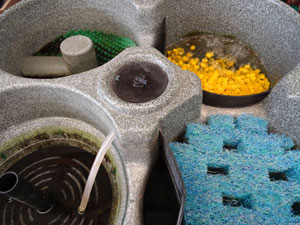
By concentrating on keeping healthy water, you can be confident that your fish will also remain healthy.
Koi carp excrete far more ammonia (mainly through their gills) than other pond fish, and they grow considerably larger, meaning that your water quality will suffer unless you have adequate filtration.
A pond filter comes in many guises, with filtration media ranging from coarse brushes, flocor tubes, Japanese matting, gravel, alfagrog, lava rock, sand, bio balls and foam, with bubbling airstones often being desirable for some media.
Nitrogen Cycle
Arguably, the filtration system on any koi pond is the most important part, so don't be tempted to cut corners or skimp on this aspect of your design.
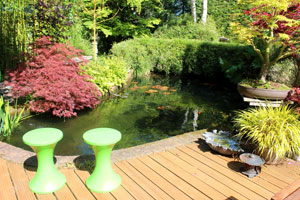
A filter works in two ways, providing mechanical filtration to sieve out small particles in the water and improve the clarity, while biological filtration makes use of beneficial bacteria to convert the harmful ammonia to nitrite, and the nitrite to less harmful nitrate.
By growing plants in your last filter chamber, this nitrate can be absorbed, although the layer of algae growing on the sides of the pond will also help reduce the amount of nitrate in the water. Ideally, oversize your filter units, particularly if you are planning to overstock your pond, and do consider how much time it will take to maintain each month. By installing flush valves at the bottom of the filter bays (if raised), it will help to reduce your workload, while sunken gravity filters have the advantage that they don't need such a powerful pump to operate.
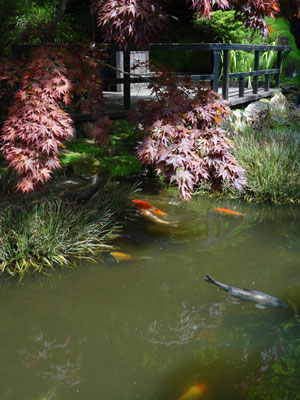
Raised or Sunken Gravity Systems?
If you have opted for a raised pond filtration system, then it theory you can situate this more than 50 feet away from your pond, provided that you have a powerful pump and use a pipe with a diameter of at least two inches. This allows you to hide your potentially unsightly filtration behind a bush or garden shed, while sunken filters are best positioned beneath nearby decking, with access panels to allow for maintenance.
If you have space, it is sensible to add some kind of prefilter at the beginning of your bays, such as a vortex or settling chamber, ultimately improving the overall clarity of the water. In general, the total volume of your pond should pass through your filter unit at least once every three hours.
UV Lights and Water Clarity
An ultraviolet light (UV light) is an essential addition to a koi pond filter system, since it kills algae and stops your water from going green. Once the algae has died, it will gradually begin to clump together (flocculate), allowing it to be removed by the filter. Of note, UV lamps need to be changed each year in spring, to ensure that they are working at their optimum.
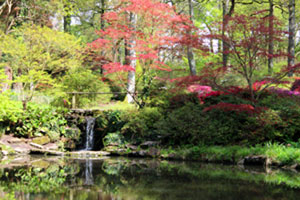
Avoid any sharp objects in your pond, such as rocks, since these can damage your koi carp and cause injuries. Also, resist the temptation to add gravel or pebbles to the bottom, as this layer will only serve to collect debris and will soon look dirty.
Mistakes and Additions
Common mistakes include building koi ponds that are too small and too shallow, with little or no filtration and far too many fish, without adequate space for them to grow.
Consider adding an air pump, surface skimmer, water jets and some underwater lights, and perhaps a fence around the water for safety purposes, if you have young children or animals.
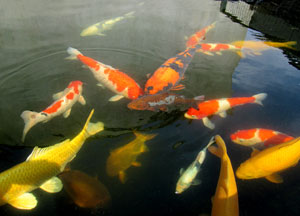
Popular Types of Koi Carp
When selecting fish, bear in mind that your koi carp will look more impressive when they are similar colours, such as a pond filled with large red, white and black fish (kohaku, sanke and showa varieties), or single colour yellow and platinum 'ogons'. However, koi carp now come in a vast array of colours and patterns, with some even having long 'butterfly' fins, and so the choice is very much a personal one.
Of course, if you want an easier life, then it may be sensible to opt for smaller, less-demanding goldfish, comets and shubunkins, or some golden orfe.
 By concentrating on keeping healthy water, you can be confident that your fish will also remain healthy.
By concentrating on keeping healthy water, you can be confident that your fish will also remain healthy. A filter works in two ways, providing mechanical filtration to sieve out small particles in the water and improve the clarity, while biological filtration makes use of beneficial bacteria to convert the harmful ammonia to nitrite, and the nitrite to less harmful nitrate.
A filter works in two ways, providing mechanical filtration to sieve out small particles in the water and improve the clarity, while biological filtration makes use of beneficial bacteria to convert the harmful ammonia to nitrite, and the nitrite to less harmful nitrate.
 Avoid any sharp objects in your pond, such as rocks, since these can damage your koi carp and cause injuries. Also, resist the temptation to add gravel or pebbles to the bottom, as this layer will only serve to collect debris and will soon look dirty.
Avoid any sharp objects in your pond, such as rocks, since these can damage your koi carp and cause injuries. Also, resist the temptation to add gravel or pebbles to the bottom, as this layer will only serve to collect debris and will soon look dirty.